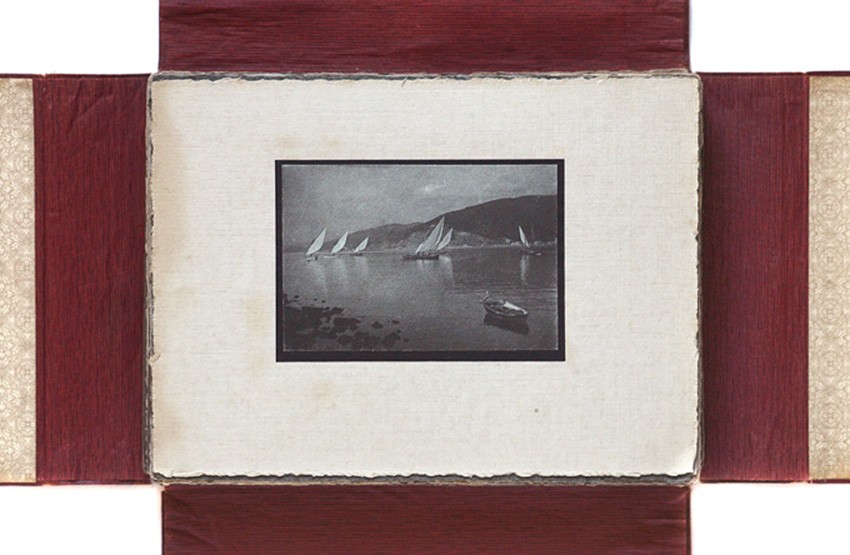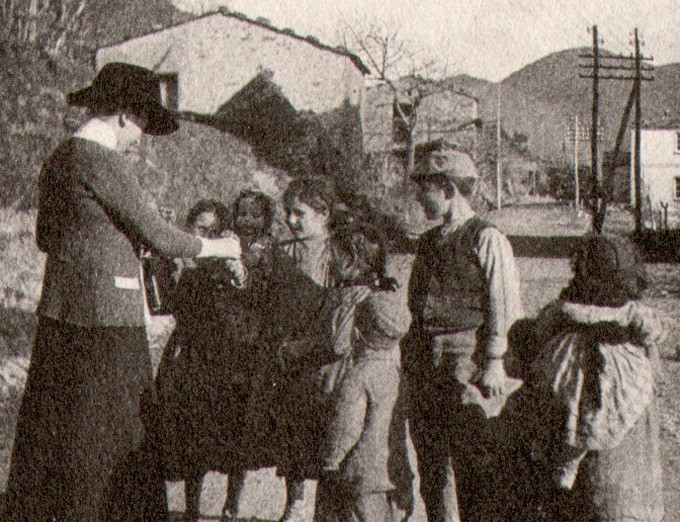2012 will mark a century since a lovely collection of photographs of Italy were taken and assembled into a personal, miniature Grand Tour type album recently added to our collection here at PhotoSeed. As photographs, I feel they stand on their own strong merits but alas, an elusive missing piece for posterity is a record of their maker. Stamped on the cover is the simple title of its’ contents: Jtalien 1912 (Italy 1912). After purchasing it from a gentleman in Holland several years ago, I quickly deduced the photos were of German origin.

“Jtalien 1912” is the name embossed on the cover of this opened, four-flap album showing the mounted photograph “Sailboats on Lake” : image: 7.3 x 10.7 cm : mount: 15.5 x 21.3 cm atop others contained within it.
In this regard, language was the clue. Other German material in our archive contains this early spelling for Italy in the German language as well as Italian using the capitol letter “J” instead of an I: Jtalien and Jtalienische. But what sealed the deal for me was the curious addition to the album in the form of a later mounted snapshot of a group of 12 men wearing military clothing. A small sign propped up in front of them states “1914 Feldzug 1915”.

Detail: “1914 Feldzug 1915 : German World War I Soldiers” : (7.8 x 10.4 cm) this portrait of World War I, German Imperial Army soldiers may be a clue to who is responsible for taking the photographs making up the 1912 album.
From this photograph I determined they are wearing World War I issue, Imperial German Army uniforms. “Feldzug” further translates to “Campaign” in German. I’m no military expert, but these guys don’t exactly look like they have just returned from the front lines. Instead, they are smiling, one holds a cigar, and another bearded soldier propped up in the back row poses for the camera while placing his hands on the shoulders of his comrades. Two women flank the group and appear to be nurses of some kind. A military hospital setting? Or perhaps soldiers on an extended R&R assignment? Is the same elusive photographer responsible for the marvelous images in this album sitting among them? And why not the possibilty one of the nurses could actually be our photographer? How did this album end up in the Netherlands, which remained neutral during The Great War? For these questions I have no answers at the moment, just more questions.

Detail: “Women on Horseback”: (7.5 x 10.4 cm) Another clue to the origins of the album?
Another potential clue to the album’s familial origin is the inclusion of a photograph of two women sitting side-saddle on horses. They may only be part of a larger party connected with the album’s fox hunt gathering photographs or merely a separate moment of repose while they take a pleasure ride in another location.

Detail: from album photograph titled: “Woman Greets Italian Village Children”. (9.6 x 8.0 cm) The woman on left appears to be presenting this group of Italian village children with a bottle (wine?) and clutch of flowers.
My own hunch is the woman looking directly into the camera on horseback is the same woman shown in a separate album photograph. In it, she presents several gifts-a bottle of wine (?) and clutch of flowers to a group of Italian village children, several barefoot. But again, deductions, not facts.

Detail: from album photograph titled: “Village Children Gathered for Portrait”. (9.8 x 7.9 cm) The same children pose for a photograph against a stone wall. Compositionally, this image is different than others in the album and is printed on gelatin silver paper, instead of a pigment process used for the majority of the photographs.
What I can say conclusively about the album’s 60 or so mounted photographs is they are a visual delight and important record of Italy before the outbreak of World War I. Some of the images are strikingly beautiful: the Italian countryside in particular but also of subject matter one rarely sees in “typical” Grand Tour type albums (not the commercial or snapshot variety) : carefully framed and presented images of dirt roads, life in a back alley, a woman in bonnet caught unawares while most likely harvesting mussels at the seashore, a mysterious detail of a gate affixed with several crosses as well as many of the country’s famous landmarks and important Roman Catholic churches.

Detail: album photograph: “Man Working in Alleyway” : 10.9 x 8.5 cm

Album photograph: Arch of Constantine: 7.9 x 10.8 cm
These photographs are not topographical records but instead are done with a pronounced pictorialist aesthetic. Printed in multiple colors (ozobrome-a transfer pigment process-may be a hunch for some) and mounted on colored supports-they are individual jewels waiting for your own critical eye. Please follow this link to make your own Italian pilgrimage to the past.



